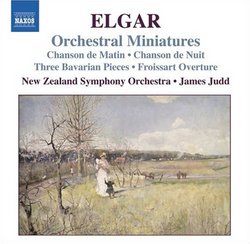| All Artists: Edward Elgar, James Judd, New Zealand Symphony Orchestra Title: Elgar: Orchestral Miniatures Members Wishing: 0 Total Copies: 0 Label: Naxos Original Release Date: 1/1/2006 Re-Release Date: 8/29/2006 Genre: Classical Styles: Chamber Music, Forms & Genres, Concertos, Symphonies, Theatrical, Incidental & Program Music, Instruments, Reeds & Winds, Strings, Symphonies Number of Discs: 1 SwapaCD Credits: 1 UPC: 747313257720 |
Search - Edward Elgar, James Judd, New Zealand Symphony Orchestra :: Elgar: Orchestral Miniatures
 | Edward Elgar, James Judd, New Zealand Symphony Orchestra Elgar: Orchestral Miniatures Genre: Classical
|
Larger Image |
CD Details |
CD ReviewsOrchestral Tidbits by Elgar J Scott Morrison | Middlebury VT, USA | 08/29/2006 (4 out of 5 stars) "Getting the right orchestral sound for Elgar is harder than it might seem. It is rare that a non-English orchestra does. The New Zealand Symphony Orchestra, a marvelous group who seem to be making more recordings in recent years, does it well. They somehow get that Edwardian feel that American and especially Austro-German orchestras never quite manage. Listen, for instance, to the little string portamento at :40 of the 'Froissart Overture.' Marvelous. It's delicately done but still noticeable and precisely right. And they also don't overdo the trudging basses that can sound so heavy and heartless in less in-the-style orchestras. James Judd, of course, is a British conductor and that probably counts for a lot here.
Amazon has not, as of this review, listed the contents of the CD. They are: Froissart Overture; May Song; Carissima; Romance for Bassoon and Orchestra, Op. 62 (Preman Tilson, bsn); Three Characteristic Pieces, Op. 10; Minuet, Op. 21; Chanson de Nuit & Chanson de Matin, Op. 15; Three Bavarian Dances. None of these works, except for the familiar Froissart Overture, are terribly familiar to concert audiences (in the US, at least) nor is any (again excepting Froissart) longer than about five minutes long. They have more than a whiff of the salon about them, but there's nothing wrong with that, at least in Elgar's hands. Bassoonist Tilson makes a good case for the Romance, a piece I'd never encountered before. It's a lovely, songful piece written at the same time as the marvelous Violin Concerto. 'Carissima' was written in 1913 specifically for recording and understandably has a popular intent. The Three Characteristic Pieces are 1) Mazurka, 2) Sérénade Mauresque, and 3) Contrasts: The Gavotte. For some reason they are not played consecutively; the Minuet is played between 1) and 2). Sérénade Mauresque is no more Moorish than I am, and reminds one of Ketèlbey's 'oriental' concoctions. The Chansons de Nuit and de Matin are played in reverse order to that in which they are printed but rather in the order in which they were composed. They were originally violin/piano pieces but are more often heard in orchestral garb. Both have lovely, memorable melodies set in sweet harmonies. The Three Bavarian Dances were originally choral settings. The first, 'Dance', has its share of oompah basses; the second, subtitled 'Lullaby' is another sweet melody but with a genial skipping countermelody; the third, taken from the choral section called 'The Huntsman', imitates the sounds and rhythms of a shooting club contest. It's bracing and an exciting ending to this fine collection of miniatures. Scott Morrison" |

 Track Listings (13) - Disc #1
Track Listings (13) - Disc #1